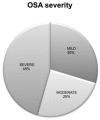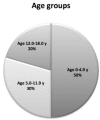Prevalence of Obstructive Sleep Apnea in Children with Down Syndrome
- PMID: 26612391
- PMCID: PMC4763351
- DOI: 10.5665/sleep.5554
Prevalence of Obstructive Sleep Apnea in Children with Down Syndrome
Abstract
Study objectives: To evaluate the prevalence of obstructive sleep apnea (OSA) in a large cohort of children with Down syndrome (DS), and to investigate which patient- related factors correlate with disease severity.
Methods: We performed a retrospective, cross-sectional study in children with DS referred for full overnight polysomnography in a tertiary care center.
Results: Polysomnographic data are available for 122 children (70 boys), age 5.0 y (2.8-10.5), and body mass index (BMI) z-score 0.7 (-0.3 to 1.7). The overall prevalence of OSA was 66.4%. In almost half of these children severe OSA was diagnosed (obstructive AHI [oAHI] ≥ 10/h). In children with parental reports of snoring or witnessed apneas (group A), OSA was significantly more common (75.7%) than in those without these symptoms (group B) 53.8% (P = 0.019). Children in group A had more severe OSA, oAHI 5.7/h (1.7-13.8) compared to those in group B 2.2/h (0.8-8.0) (P = 0.018). A significant inverse correlation between age and oAHI (P = 0.028) was found. Sex and BMI z-score were not significantly correlated to oAHI.
Conclusions: Based upon full night polysomnography, an overall 66.4% prevalence of OSA was found in children with Down syndrome. Even in those with a negative history for OSA, the prevalence was 53.8%. Younger age was associated with more severe disease.
Keywords: Down syndrome; obstructive sleep apnea; polysomnography.
© 2016 Associated Professional Sleep Societies, LLC.
Figures
Similar articles
-
Prevalence, associated risk factors, and respiratory event distribution of obstructive sleep apnea in children with Down syndrome.Sleep Breath. 2024 Mar;28(1):251-260. doi: 10.1007/s11325-023-02900-6. Epub 2023 Aug 10. Sleep Breath. 2024. PMID: 37563524
-
Prevalence and predictors of obstructive sleep apnoea in young children with Down syndrome.Sleep Med. 2016 Nov-Dec;27-28:99-106. doi: 10.1016/j.sleep.2016.10.001. Epub 2016 Oct 22. Sleep Med. 2016. PMID: 27938928
-
Outcome of adenotonsillectomy in children with Down syndrome and obstructive sleep apnoea.Arch Dis Child. 2017 Apr;102(4):331-336. doi: 10.1136/archdischild-2015-310351. Epub 2016 Aug 2. Arch Dis Child. 2017. PMID: 27484971
-
Prevalence of Obstructive Sleep Apnea in Children With Down Syndrome: A Meta-Analysis.J Clin Sleep Med. 2018 May 15;14(5):867-875. doi: 10.5664/jcsm.7126. J Clin Sleep Med. 2018. PMID: 29734982 Free PMC article.
-
Obstructive sleep apnea syndrome in non-obese patients.Sleep Breath. 2022 Jun;26(2):513-518. doi: 10.1007/s11325-021-02412-1. Epub 2021 Jul 29. Sleep Breath. 2022. PMID: 34324126 Free PMC article. Review.
Cited by
-
Early intervention for obstructive sleep apnoea in Down syndrome - making a difference?Lancet Reg Health Eur. 2024 Sep 13;45:101074. doi: 10.1016/j.lanepe.2024.101074. eCollection 2024 Oct. Lancet Reg Health Eur. 2024. PMID: 39314525 Free PMC article. No abstract available.
-
Obstructive sleep apnea in patients with Down syndrome: current perspectives.Nat Sci Sleep. 2018 Sep 13;10:287-293. doi: 10.2147/NSS.S154723. eCollection 2018. Nat Sci Sleep. 2018. PMID: 30254502 Free PMC article. Review.
-
Pulse transit time as a diagnostic test for OSA in children with Down syndrome.J Clin Sleep Med. 2022 Jan 1;18(1):119-128. doi: 10.5664/jcsm.9510. J Clin Sleep Med. 2022. PMID: 34170228 Free PMC article.
-
Prevalence, associated risk factors, and respiratory event distribution of obstructive sleep apnea in children with Down syndrome.Sleep Breath. 2024 Mar;28(1):251-260. doi: 10.1007/s11325-023-02900-6. Epub 2023 Aug 10. Sleep Breath. 2024. PMID: 37563524
-
Sleep-Disordered Breathing and Associated Comorbidities among Preschool-Aged Children with Down Syndrome.Children (Basel). 2024 May 28;11(6):651. doi: 10.3390/children11060651. Children (Basel). 2024. PMID: 38929231 Free PMC article.
References
-
- Bull MJ Committee on G. Health supervision for children with Down syndrome. Pediatrics. 2011;128:393–406. - PubMed
-
- Shott SR. Down syndrome: common otolaryngologic manifestations. Am J Med Genet C Semin Med Genet. 2006;142C:131–40. - PubMed
-
- Chin CJ, Khami MM, Husein M. A general review of the otolaryngologic manifestations of Down syndrome. Int J Pediatr Otorhinolaryngol. 2014;78:899–904. - PubMed
-
- Shott SR, Amin R, Chini B, Heubi C, Hotze S, Akers R. Obstructive sleep apnea: should all children with Down syndrome be tested? Arch Otolaryngol Head Neck Surg. 2006;132:432–6. - PubMed
-
- Mitchell RB, Call E, Kelly J. Ear, nose and throat disorders in children with Down syndrome. Laryngoscope. 2003;113:259–63. - PubMed
MeSH terms
LinkOut - more resources
Full Text Sources
Other Literature Sources
Medical




